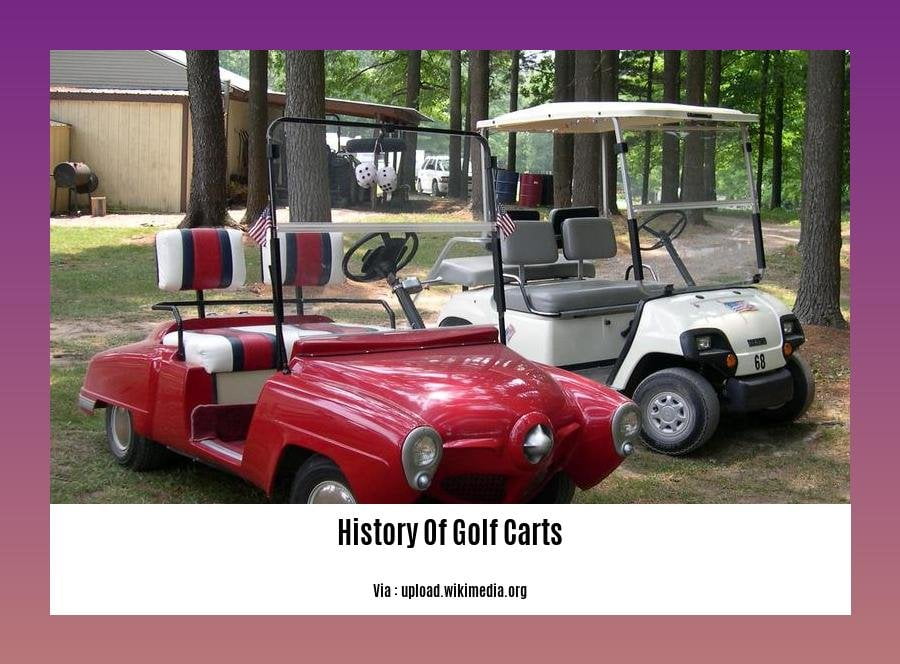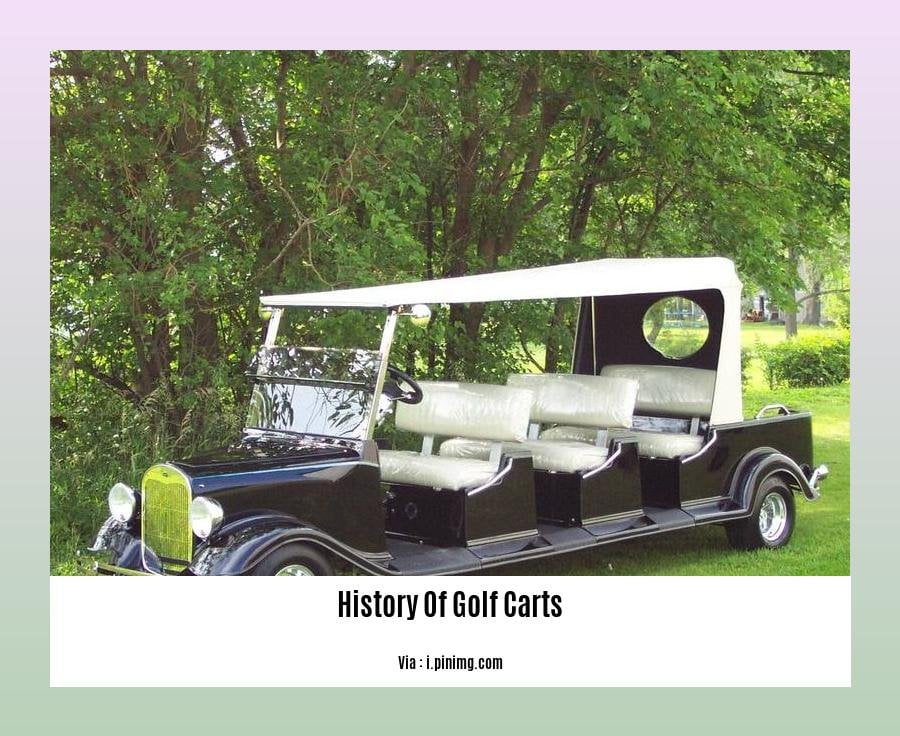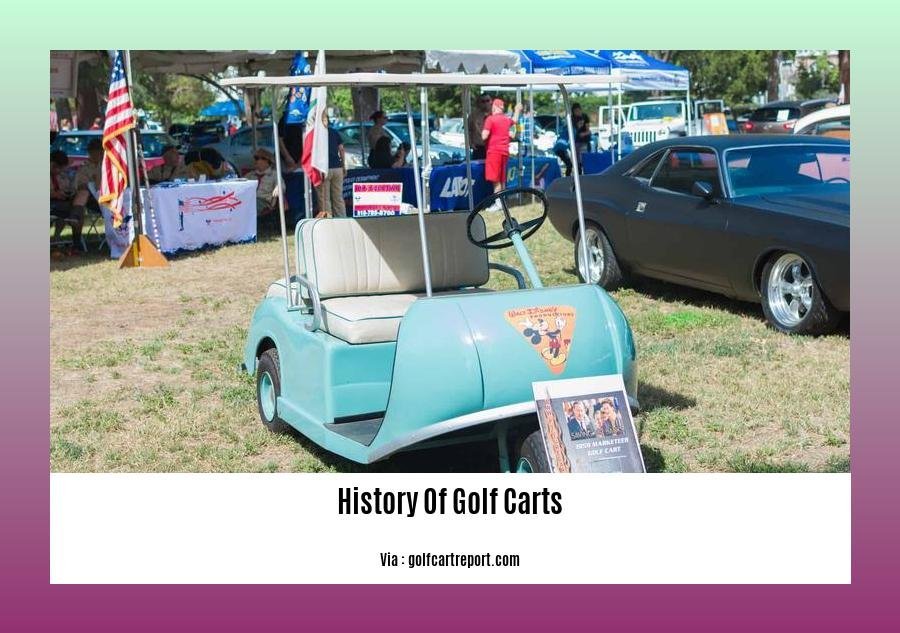From humble beginnings as motorized caddies to the advanced, eco-friendly vehicles we see today, golf carts have revolutionized the game of golf, making it more accessible, enjoyable, and efficient for players of all ages and abilities. Join us as we embark on a journey through time, exploring the fascinating history of golf carts and their transformative impact on the sport, in this intriguing article titled [A Wheeled Revolution: Exploring the History of Golf Carts].
Key Takeaways:
Lyman Beecher invented the first golf cart in 1932 to assist himself with arthritis while playing golf.
William F. Crosby designed the first motorized golf cart in the late 1930s.
Max Walker created the first gasoline-powered golf cart called “The Walker Executive” in 1957.
Companies like E-Z-Go, LEKTRO, Cushman, Club Car, Taylor-Dunn, and Harley-Davidson entered the golf cart manufacturing industry in the 1950s and 1960s.
History of Golf Carts

The history of golf carts is a tale of innovation, convenience, and transformation, mirroring the evolution of the sport itself. From humble beginnings as motorized caddies to the advanced, eco-friendly vehicles we see today, golf carts have revolutionized the way we play the game.
Early Beginnings
The first golf cart was born out of necessity. In 1932, Lyman Beecher, a Florida golfer battling arthritis, couldn’t walk the course like he used to. So, he ingeniously created a rickshaw-style cart pulled by two caddies. This early prototype laid the groundwork for the motorized marvels that would follow.
The Rise of Motorized Carts
In the late 1930s, William F. Crosby, an American inventor, took the next step by designing the first motorized golf cart. His invention opened the door to a new era of convenience and accessibility on the golf course.
The Gasoline Revolution
In 1957, Max Walker introduced the first gasoline-powered golf cart, aptly named “The Walker Executive.” This innovation marked a significant milestone, as gasoline-powered carts offered greater range and power, quickly becoming the industry standard.
The Proliferation of Golf Cart Manufacturers
The 1950s and 1960s witnessed a surge in golf cart manufacturing companies. E-Z-Go, LEKTRO, Cushman, Club Car, Taylor-Dunn, and even Harley-Davidson joined the fray, each contributing to the growing popularity of golf carts.
Modern Advancements
Today’s golf carts are a far cry from their humble origins. They’re equipped with advanced features like GPS navigation, Bluetooth connectivity, and even built-in coolers. The rise of electric golf carts has also led to a greener, more environmentally friendly game.
The Impact on the Game
The evolution of golf carts has had a profound impact on the game. They’ve made it more accessible to people of all ages and abilities, allowed golfers to play longer rounds without fatigue, and opened up the game to new markets and demographics.
A Wheeled Revolution
From Beecher’s rickshaw-style cart to today’s high-tech marvels, golf carts have come a long way. They’ve revolutionized the way we play the game, making it more enjoyable, convenient, and inclusive for golfers worldwide.
As we look to the future, it’s exciting to imagine what new innovations await us in the world of golf carts. The future of the game looks bright, driven by a spirit of innovation that’s as old as the game itself.
Dive into the enthralling history of gloves, an accessory that has transcended time, and discover their captivating journey from utilitarian tools to fashion statements, with a click here.
Journey through the fascinating history of greeting cards, from their humble origins as simple messages to the elaborate and heartfelt expressions of today, with a click here.
Delve into the captivating history of gym shoes, from their simple beginnings as practical footwear to the stylish and high-performance sneakers of today, with a click here.
Technological Advancements: The Rise of Lithium-Ion Batteries
The evolution of technology has left an indelible impact on the world of golf carts, and the rise of lithium-ion batteries stands as a testament to this transformation. These cutting-edge power sources ushered in a new era of efficiency, extended range, and enhanced performance for golf carts, revolutionizing the way the game is played.
Lithium-ion batteries are lightweight, compact, and capable of storing large amounts of energy compared to their lead-acid predecessors. This breakthrough paved the way for golf carts to travel longer distances on a single charge, expanding the horizons of the golf course. With their extended range, players gained the freedom to navigate the course without the fear of running out of power mid-round, enhancing their overall playing experience.
Beyond efficiency, lithium-ion batteries are also renowned for their durability and longevity. Unlike lead-acid batteries, which require frequent maintenance and replacement, lithium-ion batteries can endure hundreds of charge cycles, ensuring a longer lifespan. This not only reduces maintenance costs for golf course operators but also contributes to a more sustainable future by minimizing battery waste.
The adoption of lithium-ion batteries in golf carts has also propelled advancements in the realm of performance. Improved battery technology enables golf carts to accelerate and climb hills more efficiently. This translates to a smoother, more enjoyable ride for players, allowing them to traverse challenging terrains with ease. The enhanced power and torque of lithium-ion batteries also make golf carts ideal for carrying heavy loads or transporting multiple passengers.
Key Takeaways:
- Lithium-ion batteries revolutionized golf carts with their high energy density, allowing them to travel longer distances on a single charge.
- These batteries are lightweight, compact, and require minimal maintenance, reducing costs and environmental impact.
- Lithium-ion batteries provide superior power and torque, enhancing golf cart performance and enabling them to handle challenging terrains and carry heavy loads.
- Their extended lifespan contributes to sustainability by reducing battery waste.
Sources:
[1]
[2] https://www.asme.org/topics-resources/content/advancing-battery-technology-lithium-ion-solid-state
Environmental Consciousness: The Shift Towards Sustainable Golf Carts

Golf carts have come a long way since their humble beginnings as motorized caddies. Today, they are an essential part of the game, providing convenience, accessibility, and environmental sustainability.
In this article, we’ll explore the environmental impact of golf carts and the industry’s shift towards sustainable practices.
The Environmental Impact of Golf Carts
Traditional fuel-powered golf carts can contribute to environmental concerns due to their reliance on gasoline, which emits greenhouse gases and air pollutants. These emissions can negatively impact air quality and contribute to climate change.
The Shift Towards Sustainable Golf Carts
The golf cart industry is responding to these environmental concerns by adopting sustainable practices. Manufacturers are developing and producing electric golf carts that run on electricity rather than gasoline. Electric golf carts produce zero emissions, reducing air pollution and greenhouse gas emissions.
Benefits of Sustainable Golf Carts
The benefits of sustainable golf carts extend beyond their environmental impact. Electric golf carts are often quieter than gasoline-powered carts, reducing noise pollution on the course. They are also more energy-efficient, requiring less energy to operate.
Challenges of Sustainable Golf Carts
While the shift towards sustainable golf carts is a positive trend, there are still some challenges that need to be addressed.
One challenge is the relatively high cost of electric golf carts compared to gasoline-powered carts. However, the long-term savings in fuel and maintenance costs can offset the higher initial investment.
Another challenge is the limited range of electric golf carts. While most electric golf carts can travel 18 holes on a single charge, some courses may require a longer range. Manufacturers are working to develop electric golf carts with longer ranges to meet the needs of all golfers.
The Future of Sustainable Golf Carts
The future of golf carts is bright. As technology continues to advance, we can expect to see even more sustainable and innovative golf carts on the market.
Solar-powered golf carts, which can generate their own electricity from the sun, are already in development. These carts would completely eliminate the need for fossil fuels, making them the ultimate sustainable golf cart.
Key Takeaways:
- Eco-friendly Materials: Sustainable golf carts utilize recycled plastics and lightweight metals, reducing waste and carbon emissions.
- Energy-Efficient Systems: LED lighting and regenerative braking conserve energy and fuel.
- Alternative Fuels: Solar and electric power sources offer zero emissions and reduced noise pollution.
- Solar-Powered Charging: Renewable energy harnesses the sun to charge electric golf carts.
- Sustainable Course Practices: Efficient irrigation and habitat conservation contribute to overall golf course sustainability.
Sources:
- The Environmental Impact of Golf Carts and Sustainable Practices
- Working towards greener golf carts
Modern Innovations: The Future of Golf Cart Technology
From Caddie to Cutting-Edge: A Revolution on Wheels
Golf carts have come a long way since their humble beginnings as motorized caddies, evolving into sophisticated vehicles that enhance the golfing experience. Let’s delve into the innovative future of golf carts:
- Electric Revolution:
Electric golf carts are gaining momentum, offering eco-friendly alternatives to gasoline-powered models. These carts run on rechargeable batteries, reducing emissions and providing a quieter ride on the course.
- GPS Integration:
Golf carts are becoming smarter with integrated GPS systems. These systems provide real-time course information, distances to the hole, and even hazard warnings, helping golfers navigate the course more effectively.
- Bluetooth Connectivity:
Modern golf carts often feature bluetooth connectivity, allowing golfers to connect their smartphones and stream music, answer calls, or even track their scores digitally.
- Customizable Comfort:
Customization is key in modern golf carts. From adjustable seats to built-in coolers and storage compartments, golf carts are designed to provide a comfortable and personalized ride for each golfer.
- Safety Features:
Safety is paramount, and modern golf carts often come equipped with advanced safety features such as seat belts, headlights, taillights, and even reverse cameras, ensuring a safe and secure ride.
Key Takeaways:
Electric golf carts are gaining popularity, offering eco-friendly and quieter alternatives.
GPS integration provides real-time course information, aiding golfers in course navigation.
Bluetooth connectivity allows golfers to connect their devices and enhance their golfing experience.
Customizable features ensure a comfortable and personalized ride for each golfer.
Advanced safety features prioritize the well-being of golfers on the course.
Sources:
- Golf Car Evolution: A Modern Approach to Course Mobility
- The Future of Golf Carts
FAQ
Q1: How did the first golf cart come into existence?
A1: The initial concept of a golf cart emerged in 1932 when Lyman Beecher, an individual with arthritis, desired a solution to assist him during his golfing sessions. He invented a rickshaw-style cart pulled by two caddies, marking the inception of golf cart history.
Q2: Who is credited with designing the first motorized golf cart?
A2: William F. Crosby, an American inventor, played a pivotal role in the evolution of golf carts. In the late 1930s, he conceptualized and designed the first motorized golf cart, laying the foundation for future advancements in golf cart technology.
Q3: When was the first gasoline-powered golf cart introduced, and who created it?
A3: The introduction of the first gasoline-powered golf cart marked a significant milestone in the history of golf carts. In 1957, Max Walker, a visionary inventor, created “The Walker Executive,” which became the first golf cart to utilize gasoline as its primary power source.
Q4: Which companies played a significant role in the manufacturing of golf carts in the 1950s and 1960s?
A4: Several companies emerged as pioneers in the manufacturing of golf carts during the 1950s and 1960s. Notable among them were E-Z-Go, LEKTRO, Cushman, Club Car, Taylor-Dunn, and Harley-Davidson, who collectively contributed to the growing popularity and widespread adoption of golf carts.
Q5: What innovations transformed the golf cart market in the 1970s?
A5: The 1970s witnessed several transformative innovations that revolutionized the golf cart market. The introduction of four-wheel models provided enhanced stability and maneuverability, while the integration of gasoline engines offered increased power and efficiency. These advancements significantly influenced the design and functionality of golf carts, shaping their modern-day form and capabilities.
- Crypto Quotes’ Red Flags: Avoid Costly Mistakes - June 30, 2025
- Unlock Inspirational Crypto Quotes: Future Predictions - June 30, 2025
- Famous Bitcoin Quotes: A Deep Dive into Crypto’s History - June 30, 2025
















